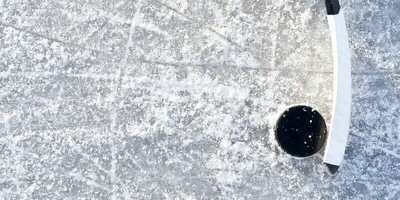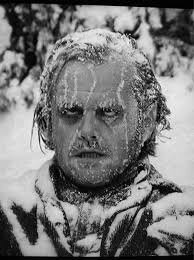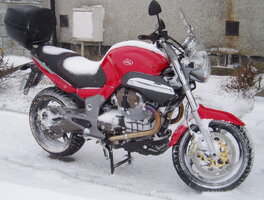I've been commenting on this for years but it has mostly fallen on deaf ears. As temperatures drop, the properties of the rubber in tires changes to where it reaches the so called "glass point". This is a problem for cars, but even more so for motorcycle tires as traction is needed just to stay upright. I've advised folks not to ride when the temps drop below 30 degrees F but many said it wasn't a problem. Here is an article from Fox news that discusses the issue. foxnews.com/auto/dont-drive-winter-storm-tires-snowing
Navigation
Install the app
How to install the app on iOS
Follow along with the video below to see how to install our site as a web app on your home screen.
Note: This feature may not be available in some browsers.
More options
-
Ciao Guest - You’ve landed at the ultimate Guzzi site. NEW FORUM REGISTRATIONS REQUIRE EMAIL ACTIVATION - CHECK YOUR SPAM FOLDER - Use the CONTACT above if you need help. New to the forum? For all new members, we require ONE post in the Introductions section at the bottom, in order to post in most of the other sections. ALWAYS TRY A SEARCH BEFORE STARTING A NEW TOPIC - Most questions you may have, have likely been already answered. DON'T BE A DRIVE-BY POSTER: As a common courtesy, check back in and reply within 24 hours, or your post will be deleted. Note there's decades of heavily experienced Guzzi professionals on this site, all whom happily give endless amounts of their VALUABLE time for free; BE COURTEOUS AND RESPECTFUL!
-
There is ZERO tolerance on personal attacks and ANY HYPERLINKS to PRODUCT(S) or other competing website(s), including personal pages, social media or other Forums. This ALSO INCLUDES ECU DIAGnostic software, questions and mapping. We work very hard to offer commercially supported products and to keep info relevant here. First offense is a note, second is a warning, third time will get you banned from the site. We don't have the time to chase repeat (and ignorant) offenders. This is NOT a social media platform; It's an ad-free, privately funded website, in small help with user donations. Be sure to see the GTM STORE link above; ALL product purchases help support the site, or you can upgrade your Forum profile or DONATE via the link above.
-
Be sure to see the GTM STORE link also above for our 700+ product inventory, including OEM parts and many of our 100% Made-in-SoCal-USA GTM products and engine kits. In SoCal? Click the SERVICE tab above for the best in service, tires, tuning and installation of our products or custom work, and don't miss our GT MotoCycles® (not) art on the BUILDS tab above. WE'RE HERE ONLINE ONLY - NO PHONE CALLS MADE OR RECEIVED - DO NOT EMAIL AND ASK QUESTIONS OR ASK TO CALL YOU.
-
Like the new V100, GuzziTech is full throttle into the future! We're now running on an all-new server and we've updated our Forum software. The visual differences are obvious, but hopefully you'll notice the super-fast speed. If you notice any glitches or have any issues, please post on the Site Support section at the bottom. If you haven't yet, please upgrade your account which is covered in the Site Support section or via the DONATE tab above, which gives you full site access including the DOWNLOADS section. We really appreciate every $ and your support to keep this site ad-free. Create an account, sign in, upgrade your account, and enjoy. See you on the road in 2024.
You are using an out of date browser. It may not display this or other websites correctly.
You should upgrade or use an alternative browser.
You should upgrade or use an alternative browser.
Cold and tires
- Thread starter john zibell
- Start date
Sempervee1
Tuned and Synch'ed
True. In the cold tires lose pressure it seems also. I make it a habit to check the pressure on both our vehicles more often.
As temperatures drop, so does internal pressure. Basic physics. See aqua-calc.com/calculate/gas-pressure-and-temperature - This page relies on the ideal gas law, gas, and R is the ideal gas constant. Also to warm up tires, run a slightly lower pressure. The flexing of the tires generates heat. When I've participated in track days I drop pressure 2 to 4 PSI so the tires heat up and stick better.True. In the cold tires lose pressure it seems also. I make it a habit to check the pressure on both our vehicles more often.
Last edited:
tris
Cruisin' Guzzisti
Very interesting John.
Especially as my reaction to seeing a drop in pressure when cold would have been to add air pressure back to that specified rather than reduce it as you recommend.
I understand the logic, but it's contrary to what I would have expected.
Something to consider none the less
Thanks
Especially as my reaction to seeing a drop in pressure when cold would have been to add air pressure back to that specified rather than reduce it as you recommend.
I understand the logic, but it's contrary to what I would have expected.
Something to consider none the less
Thanks
To add .02 more cents, modern radials can run at what I (naively in my youth) considered absurdly low pressures and still work as designed for (traction). When I was racing in the '90s, extreme cold mornings predicated tire pressures as low as 19 psi. I would not hesitate to run modern radials down to 24~26 psi on super cold street rides. On the opposite side, modern track tires on the big hp bikes also are running 19 psi cold on the rear tire (on Seasonally warm/hot days), and 24 or so in the front... Counting on the ~10 psi gain when hot. They also will spin on the rim 4~6 inches per session, so they really should be rebalanced often. I feel as though this is a bit of a gimmicky trade-off for ignorant track day folks to consume tires. Pro level I get, but for track days seems silly to me.
For street use I wouldn't drop pressure. Just don't ride in the cold temperatures if you don't have to. To me it isn't worth the addition risk of low available traction. The pressure is dropped a little for track use (not as low as Todd has done) to heat up the tires a little more. I attened a tire tech session presented by Bridgestone tire that stated when the core temp of the tire reaches 100 degrees C the tire would have max traction. Motorcycle manufactures tire pressure recommendations are a trade off betwee tire life, and available traction. The higher the pressure, the cooler the tire runs, but you then have less traction. Conversely if the pressure is too low, the tire gets hot and doesn't last as long. In addition if the pressure is too low, you may also encounter poor handling issues.Very interesting John.
Especially as my reaction to seeing a drop in pressure when cold would have been to add air pressure back to that specified rather than reduce it as you recommend.
I understand the logic, but it's contrary to what I would have expected.
Something to consider none the less
Thanks
Last edited:
Sempervee1
Tuned and Synch'ed
Braver soul then me to do that in the snow.
50 km New Years day ride showing off the Griso's Christmas gifts: new alternator belt, repacked swing arm bearings, crash bars (donated by friend Steve last fall) and!! a brand new rear tire. 7 degrees C. Cornering with much care, keeping John Z's advise in mind. Home safe, didn't need the crash bars 
 . Had our snow already, hopefully the last of it. HappyNewYear everyone. Winter in Scotland looks brutal!
. Had our snow already, hopefully the last of it. HappyNewYear everyone. Winter in Scotland looks brutal!



